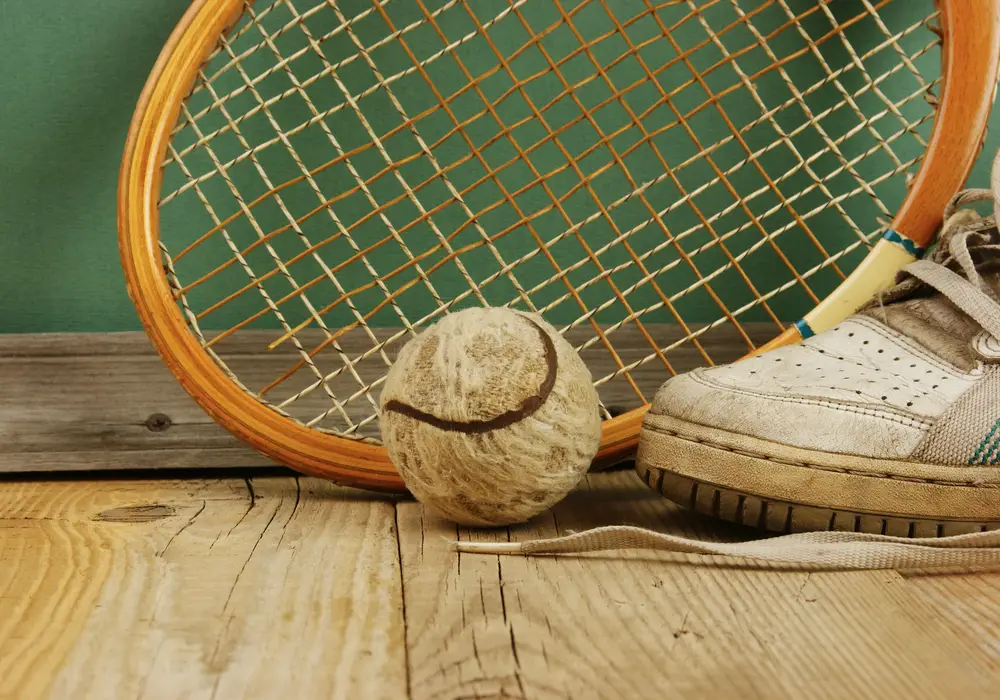Back when I lived in England, I had a tendency to go shopping before work. In my head, I thought this was fine as long as I didn’t purchase food that needed refrigerating.
England isn’t known to have the best weather, and thus the heat was something I didn’t consider.
One hot summer day, I made the mistake of leaving chocolate biscuits on the back seat.
It’s safe to say there wasn’t much chocolate left on the biscuits by the time I finished coaching.
Chocolate biscuits will absolutely melt, but what about tennis rackets? Can they melt?
Tennis rackets can melt if exposed to extreme heat. Rackets are most commonly made from graphite. The melting point of graphite is around 6500° Fahrenheit (3600° Celsius). If the racket is exposed to that heat level, it will begin to melt.
I will be discussing:
- If tennis rackets can melt in hot weather
- The effect heat has on racket strings.
- If wooden rackets can be damaged by heat
It is virtually impossible to accidentally melt your racket. Even so, it is a good idea not to expose it to heat unnecessarily. I will explain why further on.
Can A Tennis Racket Melt In Hot Weather?

The highest verified temperature ever recorded on Earth is 134°F (56.7°C). It was recorded on July 10th, 1913, at the Oasis at Furnace Creek Ranch, CA, USA.
Furnace Creek has two tennis courts if you fancy playing in extreme heat.
As unpleasant as 134°F sounds, it will not be enough to melt your racket or do any damage. Rain will do more harm than this level of heat.
The melting point explained in its simplest form is when a solid melts into a liquid.
Graphite is the most common material used for manufacturing rackets by an overwhelming margin. After graphite, it is aluminum.
The melting point of aluminum is much lower than that of graphite. The melting point for aluminum is 1220°F (660°C).
Even though it is more than 5 times less than graphite, you still have nothing to worry about.
I cannot picture any scenario where a tennis racket would accidentally end up in 1220°F.
Interestingly, the melting point of aluminum changes based on the alloy composition.
To melt aluminum, you will need to turn a furnace on and set it to 1220°F. The aluminum will melt as soon as you place it in the furnace.
Even if it appears to have melted, you should leave it for around 30 seconds to make sure it has melted completely.
I’ve no personal experience melting aluminum rackets, but I know this. If you melt 40 aluminum soda cans, you will get around 1 pound of aluminum.
If you’re melting graphite, you will need much more than a standard Muffle furnace.
The maximum temperature for this furnace is 2192°F.
How Does Heat Affect Racket’s Strings?

It’s pretty clear now that unless you shove your racket in a furnace or something similar, the racket itself will be fine.
But what about the strings? How does heat affect them?
They will always be more vulnerable to heat than the racket frame itself, no matter what string you use. Natural gut is the string most susceptible to heat than other materials.
Natural gut is made from the dried fibers of cow intestines. It is regarded as one of the best materials for string tension maintenance.
This means if you string at 60 pounds, it will hold this tension for longer than other string types.
Natural gut is one of the softest string materials available. Because of this, heat will cause the strings to lose tension very fast.
If left in the heat for a longer period, it can also cause the strings to go brittle. This will thus reduce the durability.
Regardless of the string you use, extreme heat will not do any good. For example, if you were to try and melt a racket in a furnace, the strings would melt pretty quickly.
Tennis strings do have some fire resistance, though. There are several Youtube videos of people playing tennis with balls that have been set alight.
Here is one example – Ultimate Fire Tennis Challenge.
I can’t tell exactly what strings they use in the video, but the rackets look cheap. The factory strings that come with rackets are usually for one purpose. That is durability.
I am unaware of manufacturers going out of their way to create fire resistance strings. But it does seem like the strings used in this video hold up pretty well against the flaming balls.
I’m sure it goes without saying, but I don’t recommend you start playing tennis with fireballs. Ignoring the safety risk, I’m not sure your tennis club will approve of it.
Maybe some of the kids will though.
Can A Wooden Racket Get Damaged By Heat?

I do not often see people playing with wooden rackets today, but it does happen occasionally.
Wooden rackets are more vulnerable to heat than graphite and aluminum rackets.
Even if you are playing at Furnace Creek Ranch, your rackets should be fine. That level of heat will not be enough to damage the wood.
If the wooden racket is exposed to intense heat, it will not farewell. When exposed to extreme levels of heat, wood expands. If the moisture level changes, it can also cause the wood to move a lot.
Wood cannot melt in the same way metal can. This is because the physical makeup of the wood is destroyed when set to melting temperatures. As this process is irreversible, you cannot melt wood.
The big issue is that wood is a combustible (or burnable) material. Combustion is the chemical reaction in which a flammable object (wood) decomposes due to a change in chemical composition.
When the wood begins the combustion process, it is broken down into other objects. These are water, carbon dioxide, methanol, and charcoal. Therefore, if you were to cool down the ashes of wood, it would not return to its original form.
Wood subjected to temperatures between 500-600°F will trigger a process called pyrolysis. Pyrolysis is the process in which something is decomposed due to high temperatures. Wood burning on a bonfire is an example of this process.
Once the wood has turned to ash, there is no going back.
Final Words
To summarize, as long as you are not attempting to melt your racket, it won’t happen. There is no tennis court on Earth situated somewhere hot enough to cause the racket to melt.
This goes for both graphite and wood rackets.
Have you ever attempted to melt your tennis racket? Perhaps you’ve tried burning a tennis ball.
Either way, I will be amazed if you have managed to accidentally melt a racket.

